Cobra Kit Helicopter Design
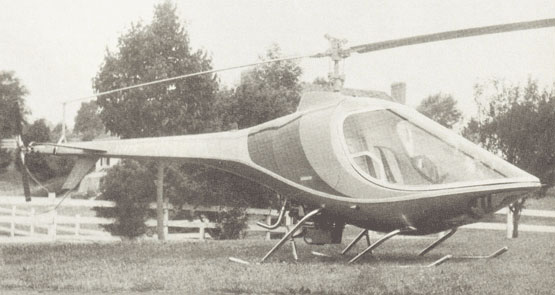
he Cobra helicopter’s body is molded with kevlar reinforced composite materials. This gave it a very futuristic look for its time.
Based on a design by Harold Emigh, the new Kevlar composite based two seat Cobra kit helicopter retains the proven reliability and precision component engineering of its time tested Commuter II.
There has never been an invention which sparked more intense desire in common man to possess it than the helicopter.
Since its beginnings in WWII as a rescue and observation vehicle, its prominence in the world of aviation continues to grow. From the very first cumbersome Sikorski helicopters which began operating from platforms and ships in very limited numbers in 1944 and 1945, to its presence in the first "helicopter war" – the Vietnam Conflict – where it spelled salvation for our troops and downed pilots but destruction for the enemy – the helicopter can perform magic as no other airplane or vehicle is capable.
Every day in every developed country, helicopters are at work: They transfer people from rooftop to airport; fight forest fires in remote mountains and canyons; spray crops to increase the production of food for our hungry world; report on traffic congestion over radio and television stations; land on highways to transport accident victims to the nearest hospital; hover over escaping criminals, directing police ground units to their location; capture movie magic with vibrationless Tyler mounts holding heavy motion picture cameras; lift cumbersome heating and air-conditioning equipment to rooftops; string power lines across canyons; and drop off rock stars behind their stages when they want to avoid traffic jams and clamoring groupies.
| LYCOMING POWERED COMPOSITE COBRA KIT HELICOPTER SPECIFICATIONS | |
|---|---|
| Engine type | Lycoming 0-320-A2B |
| Weight | 272lb (dry) |
| Power | 150hp @ 2700rpm |
| Max RPM | 2800 |
| Cruise RPM | 2700 |
| Fuel requirement | 80 octane AvGas or auto fuel |
| Ignition | Dual (2 plugs/cylinder) |
| Cruise | 90mph |
| Max (Vne) | 100mph |
| Hover (IGE) | 7000feet |
| Ceiling | 12,000 feet |
| Climb | 1000fpm |
| Fuel rate | 10 gal/hr |
| Fuel capacity | 22gal |
| Oil capacity | 8pts |
| Oil type | SAE 40/80 |
| Range | 200mi plus reserve |
| Gross weight | 1400lb |
| Empty weight | 800lb |
| Payload | 600lb |
| Seating | 2-place side by side |

The Cobra helicopter’s main rotor drive transmission assembly, swashplate and tail rotor drive are common on all models except the turbine powered Predator helicopter.
They have been called many names – whirlybirds, fling-wings, wopwops, hoptycopters, choppers, and helos. Some of the military attack birds could hold more ordnance than many WWII fighters. They are incredibly useful flying machines which have a reputation of being very hard to fly, hard to maintain and very expensive to own. Nevertheless, the helicopter is the "do everything" aircraft of choice. How did the world operate before Igor had his brainstorm? With far less facility, I’m sure.
Years ago, there were a few fairly inexpensive helicopters, like Brantly and Enstrom, which met the demands of General Aviation pilots to a degree. Today, the least expensive in the Robinson R-22 _ a diminutive two-passenger with a small 150 Lycoming for power. The little Robinson is in great demand as a trainer and for use by airborne traffic reporters. Its still somewhat limited performance and still hefty price tag, even by todays standards, kept the little R-22 from being the :helicopter in every garage" which many envisioned would be the norm in the years after WWII.
One of the reasons why this has not yet been achieved is that a helicopter is a very complex machine. It has many crucial moving parts which must be scrupulously maintained. Furthermore, because they are not inherently stable, they must be flown with both hands at all times. The use of helicopter controls is foreign to the learned flight responses of the fixed – wing pilots and a new set of reflexes must be learned. And many felt that only the expensive helicopters were safe.
Some homebuilders disagreed with the last statement. They thought that most of the design parameters were too complex, and that there must be an easier way to perform the same job. Some even believe that the ultimate helicopter mechanisms have not yet been invented.
Companies like Rotorway in Arizona, directed by genius designer B.J. Schramm, have struggled for decades perfecting homebuilt helicopters only to be forced into bankruptcy because of rising costs and liability problems. Other helicopter companies have attempted to rise from the ashes of other helicopter companies. All who have attempted to conquer this market agree, though, that its an uphill battle.
The story of Harold “Pop” Emigh, respected North American Rockwell aeronautical engineer, and his Helicom Commuter II homebuilt helicopter could almost be used as a textbook on the homebuilt helicopter business.
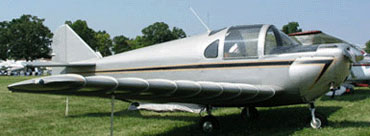
The Emigh Trojan aeroplane. Being of symmetrical design reduced manufacturing time and cost.
Harold Emigh’s first contribution to private aircraft development was his Emigh Trojan, an advanced all – metal two – passenger light aircraft whose flying surfaces had the ribs on the outside of the wing. Furthermore, it was designed so that the right wing could be flipped over to become the left wing, etc., and the right horizontal fin and elevator could become the left horizontal fin and elevator, or stood on in and become the vertical fin and rudder.
All parts were interchangeable, and when assembled, its performance was excellent. Lauded world – wide as a revolutionary design because of its ruggedness and simplicity, the Trojan easily won federal certification. Unfortunately, the aviation market was not ready for this tricycle – gear aircraft, so production dwindled and was shut down after a few years.

The Commuter Jr helicopter with composite cabin.
As an engineer, Emigh went on to design the Navajo Ballistic Missile System, the Polaris Navigation System, the B-70 and was called out of retirement to assist on the space recovery program.
Throughout all those years, he gained considerable experience in stress analysis and the values of materials which would be necessary for reliability and production.
In 1954, after extensive testing and perfecting, Emigh brought out his Helicom helicopter which was sold continuously until the early 1970s as the Commuter I and I I. Hundreds were successfully built from Emigh kits and flown safely for many hours.

Emigh Prototype Kit Helicopter design
While the design had great merit, the Helicom kit helicopter was somewhat similar in concept to the famous Bell 47 helicopter, still being used around the world for various tasks. Extremely slow, but inexpensive to own and operate, the Bell 47 was a classic helicopter design.
How the Helicom Commuter I and II homebuilt helicopters came about is an interesting story: Setting their goal on a lightweight and simple personal helicopter, Pop Emigh, his son Harold Emigh Jr., Program Director at North American Space concepts, and Mr. William Foster began the mission of designing and engineering.
The drawing board received a real workout as plans and dimensions were devised – from the paper plans, to the machined parts, the first Helicom helicopter grew.
Several approaches to the construction of their helicopter were examined. Emigh wanted his helicopter to be simple, but not too simple, as people tend to take shortcuts if a design is too simple.
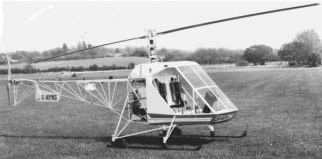
The Helicom helicopter – aka Commuter helicopter
After weight and power requirements were determined, the decision to use an aircraft engine seemed obvious.
With minimal modifications, the Continental engine could provide the power – to – weight ratio required. Many Continentals were used in the single – seaters before the switch to Lycoming.
Emigh found that V-belts and pulleys would not suffice for the tail rotor drive.
The adjustments would such attention that a simple drive shaft with universals would work much more easily, eliminating all stretch and alignment problems.
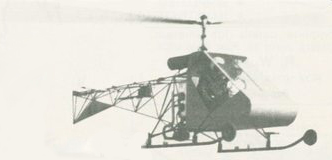
The Helicom Commuter Jr The two place helicopter flies it’s owner to work. It flew to Rialto Pop Rotor meet and won the Mechanics Illustrated award for 1973.
It is possible to commute, because of reliable components including a certified aircraft engine with dual ignition and our silent exhaust system.
The clutch design first incorporated was a common centrifugal type but Emigh did not like it. They were fine for smaller higher-revving engines but not reliably suitable for the higher powered Continental aircraft engine.
He designed a new style, one which would allow the engine to engage the blades more smoothly without jolting them as the old style tended to do.
In effect it was simply a “reverse-centrifugal clutch” where the inside was stationary with spring loaded pressure shoes and the outer part looking very much like a car drum-brake style hug, would rotate and smoothly grip the shoes to engage.

1. The reverse-centrifugal helicopter clutch to allow engine run-up before engaging the rotorblades.
2. This particular clutch is for the later Safari kit helicopter drilled for the Lycoming 160 HP engine.
3. On the left, you see the inner stationary rotor with four (4) large spring loaded “shoes” that engage to the outer drum.
4. In the center of the inner drum is the sprag or overrun clutch, mandatory in any helicopter design.
The freewheeling unit, which is a must in a helicopter if one is to survive an engine failure during flight, was designed for him by Borg Warner – the largest manufacturers of freewheeling units in the world. This is very similar to the freewheeling units as used on commercially made helicopters on the market today.

Helicom Commuter Jr Single Seat Helicopter
The Helicom Commuter Jr kit helicopter Model H-1A of the 1960’s powered by a Continental C90-12F four stroke four cylinder horizontally opposed air cooled engine providing a top speed of 121 km/h and range of 273 km. There are many still flying today.
The transmission design saves a great deal of money. In most American helicopters, a planetary gear system permits the blades to turn in the same direction as the engine, but these systems are very costly. Emigh’s design drives the rotor blades in a direction opposite to that of the engine. This design is simple and inexpensive and is a direct gear drive. This is not new, as most French helicopters are like this now.
After successful completion and extensive testing of their single – seat Helicom helicopter, they decided it was time to offer it to the public. Many single – seat Helicom Commuter helicopters used 20 – foot rotor blades. Then in 1969, a two – seater emerged and became the forerunner of the Commuter II-A kit helicopter. A switch was made to the Lycoming engine and to 23 – foot rotor blades at this time.
The two – seater helicopter started out using a certified 125 HP Lycoming aircraft engine but, as designs usually go, weight was added and essential changes needed to be made.
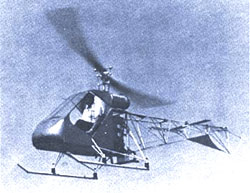
Helicom Commuter II A two seater kit helicopter
So the move to a more powerful 150 HP aircraft engine along with longer 25 – foot main rotor blades made a real performer out of the Helicom Commuter helicopter.
This engine-rotor combination seems perfect – providing the ability to carry a decent load with reserves while still being an inexpensive, well – refined kit helicopter.
During the next 20 years, the company passed through several hands, but the product never changed. Some cosmetic changes were made to the cockpit area in an attempt to streamline or modernize it a bit, but the reliable components designed by Emigh were left alone. NOTE: The current “SAFARI” kit helicopter transmission has been strengthened since this time.
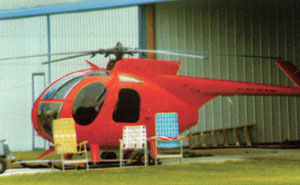
Aviation Awareness Day – Saturday July 4th, 1998, Cloverdale, Indiana: Best Helicopter trophy went to Gary Helton for his Hughes 500.
Then recently, the rights to the aircraft were purchased by Gary Helton, of Danville, Indiana who has invested much money and time into upgrading the Helicom Commuter II helicopter into a modern – looking machine using the latest in space age techniques. Gary named his new helicopter the Cobra.
The first Cobra helicopters were powered with Mazda Rotary engines and utilized a welded steel framework. They some what resembled the early Rotorway Scorpion II helicopters but with a right angle main rotor gearbox, shaft driven tail rotor and triangulated steel tube tail boom. While they were fine machines, Gary felt they looked angular, and worse, somewhat dated. A complete facelift and upgrading were in order.
He came to the conclusion that for a very reliable kit helicopter which would be capable of going away from the airport on long cross country flights, the system of the geared main transmission, tail rotor drive shaft and tail rotor gear box which Mr. Emigh had designed for the Commuter series helicopter was still the best overall system for the homebuilt helicopter.
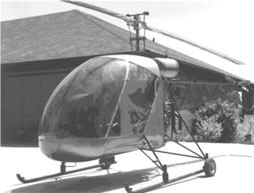
Helicom Commuter II B late model two seater helicopter
This system has been successfully used for over 34 years by homebuilders in their Helicom Commuter helicopters all over the world. The original Commuter II A helicopter for which Gary and his people were offering as plans and kits had a rather boxy looking enclosure, since when this machine was being designed the main helicopter of that era was the Bell 47 to which his helicopter had a slight resemblance in looks as well as in its transmission and rotor systems.
What they did in the Cobra is to use the same transmission system, rotor systems, tail rotor drive shaft systems, tail rotor gearbox system, the control system which was used in the Commuter II-A helicopter, along with the aircraft engine, the Lycoming 150 hp. They installed this complete system in a Kevlar sandwich structure which is very strong, lightweight, easy to assemble, as well as being very stylish. Although there is nothing wrong with the original Commuter II-A airframe, the new Cobra kit helicopter enjoys various advantages which were not available when the Commuter II-A was designed.
The Cobra kit helicopter improvements include:
▣ The Cobra is a more streamlined and stylish kit helicopter cosmetically.
▣ The Cobra kit helicopter is easier to build, since less welding and fitting is required because of the pylons and joggles are pre – molded into the composite parts.
▣ The helicopter kit is faster to build because of the pre – molded parts used – getting you in the air quicker.
▣ The Cobra kit helicopter offers more comfort to the pilot and passenger as the enclosure cabin can be sealed and heated for winter flying.
▣ The Cobra kit helicopter boasts an increased cruising speed due to the aerodynamic design – without needing more power.
▣ A wider cabin along with more leg room and more head room provide for improved pilot and passenger comfort.
▣ Improved soundproofing is included in the Cobra kit helicopter due to the engine installation and location along with the natural acoustic control of the Kevlar composite construction.
Magazine Promo:
Gary Helton’s composite bodied COBRA helicopter
The Cobra is the first kit helicopter to use a pre-molded composite kevlar structure. By using these pre-molded components, you can have this helicopter flying in a few weeks.
The Cobra helicopter also features a reliable geared main transmission and a geared tail rotor gearbox while using the Lycoming 150hp engine for it’s power plant.
Just think of all the places you can go while cruising at 100 miles per hour and landing in parking lots or yards.
Why buy that second new car, boat or R.V. when for the same price or less you can have the ultimate in transportation and fly your very own helicopter out of your backyard.
Although the Cobra helicopter cost a little more than the Commuter II A (due to the expense of the Kevlar composite structure), the people at Cobra think they are the best kit built helicopters on the market today.
The drive train and engine systems are very comparable to commercial helicopters which cost many more times the price of our kit helicopter.
When Helton decided to upgrade the Cobra kit helicopter he utilized all the modern construction techniques and materials available at the time including Kevlar and other composite components.
The helicopter’s main shell is approximately 22 feet long and is made of a composite sandwich – type of construction and uses Kevlar as its main structural material. Kevlar is the same material used in bulletproof vests and is very strong and lightweight, but expensive.
By using the composite sandwich type of construction in this structural shell, they could vary the thickness, weight and direction of weave of the material in different areas which require different strengths for the load applied to the helicopter airframe. Also, with this type of construction, they could model a very strong lightweight part into a functional streamlined load – bearing airframe structure.
The engine and transmission are molded into the main lower airframe structure. The engine mount and transmission mount are bolted to the pylon. This eliminates a great deal of the labor of welding up this type of pylon, previously required by other kit manufacturers.
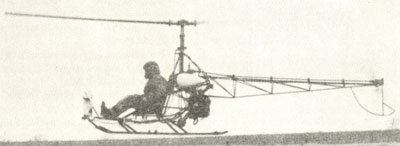
MUSTANG Rotax 503 single seat helicopter kit hovering
Also, the tail rotor pylon is molded into the tail section. This pylon supports the tail rotor drive shaft which is simply bolted to it again, saving the kit builder construction time by not requiring special jigs to be built. Also, the helicopter’s main landing gear bolts to joggles which are molded in the main airframe structure. The main airframe can be installed on its landing gear with just a few hours work.
The remainder of the composite helicopter components which are made of a composite material are non – structural tail boom coverings, transmission coverings, main cabin covering, and front rails, along with the two place seats. These coverings are non – structural and made of fiberglass with the necessary joggles molded in for proper alignment and attachment to the airframe. These parts are bolted or riveted to the main airframe, with very little fiberglass work required to be done by the builder.
| MUSTANG 503 HELICOPTER | |
|---|---|
| Engine type | Rotax 503 (50-hp) |
| Maximum speed | 75 mph |
| Rate of climb | 500 fpm |
| Endurance | 1.2 hr |
| Range | 90 miles |
| Hover in ground effect | 6000 ft |
| Service ceiling | 10,500 ft |
| Empty weight | 366 lb |
| Design gross weight | 600 lb |
| Useful load | 232 lb |
| Length overall | 22 ft |
| Height | 6.3 ft |
| Skid width | 4.0 ft |
| Disc loading | 1.91 p/sf |
| Power loading | 12 lbs/hp |
| Main rotor diameter | 20 ft |
| Chord | 8 in |
| Tail rotor diameter | 42.0 in |
| Chord | 4.0 in |
| Seating | 1 place |
| Fuel capacity | 5 gal |
These parts, along with the Cobra helicopter’s lower airframe structure, are laid up in female molds and are supplied to the customer with only one bulkhead to be fiberglassed in place by the builder. By using female molds, Cobra can supply the builder with a good quality part which requires very little, if any work to the outside of the part before painting.
Normally, all that’s required is light sanding in order that the paint with which you will be covering your helicopter will bond to the fiberglass. Also, by using the female mold process, we can lower the weight of the part while still making it structurally stronger than one fabricated by the builder. Although making the original female moulds is extremely expensive, we feel that the quality of the parts which can be produced from them are well worth the initial expense. Thus the homebuilder gets a strong, lightweight part of good quality which is easy to assemble.
Many builders beleive that helicopters are hard to fly, but that’s only because they’re not at all familiar with the controls and some of the terms and this intimidates them somewhat. Their first – asked question has always been: “What happens if the engine quits?”
As far as controls are concerned, a helicopter has a “cyclic” stick and a pair of pedals, just like an airplane, and in forward flight, these controls react just as they would in and fixed – wing craft. The difference comes in the hovering mode: movement of the main control stick, called the “cyclic” since it changes pitch of each rotor blade once (cyclically) per revolution, will cause the helicopter to move in the same direction, whether forward, backward, or sideways. The pedals are analogous to rudders, and control direction in which the nose points (but not necessarily the way the helicopter is going) by changing the pitch of the tail rotor.
There’s an additional control stick though, called the collective, since it controls the pitch of all rotor blades at once. This stick is mounted horizontally like a hand brake, next to the helicopter pilot’s left hip. Pull it up, pitch increases and the helicopter climbs; lower it and the opposite occurs. On recipical engine powered helicopters, there’s a motorcycle – stlye twist grip on the end of the collective, and one of the most important things the pilot learns is proper co – ordination of collective and throttle – obviously, more power must be applied as collective pitch increases. At the same time, a pedal adjustment has to be made for and change in power, since more power being delivered to the rotor also means more torque trying to turn the entire helicopter in the opposite direction.
Now then, about engine failures. Contrary to popular belief, the helicopter doesn’t plummet earthward if the engine fails; at least not if the pilot has his techniques down. Instead it enters a flight regime known as “autorotation”. The derivation of this term is obscure; some feel that it’s used because the blades continue to turn by themselves – “auto-matically rotating”; others joke that an early helicopter pilot once decided the the blades “oughta rotate” in an emergancy.

Single seat Mustang Rotax 503 Kit Helicopter
For a successful autorotation from anything higher than about three feet above skid height, a helicopter has to have a certain amount of energy available (below that height, the auto rotating blades themselves store enough kinetic energy to cushion a touch down). This energy can either be kinetic, i.e., speed, or potential, i.e., height. The helicopter operation manual expresses the required energy in terms of a curve, the so – called “height – velocity diagram”. (Or more familiary, the “dead – man’s curve”). Typically, a successful helicopter autorotation can be executed from the hover up to a few feet in height; any higher and you need some forward speed. As you go higher yet, you need less and less speed, since you can dive to get it; from about 300 feet you can once again shoot a good auto from a hover.
The easiest way to understand autorotation is to think of the helicopter not as a rotorcraft, but as a very small airplane (the rotor blade) flying in a very tight circle. In normal flight (with the collective raised) the “wings” fly at a positive angle of attack, producing lift and drag, just like an airplane. The drag is overcome by thrust, in this case provided by the engine turning the rotor.
Now, the engine stops. What would we do in an airplane? We’d reduce the angle of attack, i.e., lower the nose to maintain some airspeed and keep the wing from stalling. Now it’s flying at a lower angle of attack, producing less lift, but some thrust. The airplane continues to glide forward. Exactly the same thing happens with a helicopters collective control: the blade or wings nose down, and their thrust keeps the rotor turning. The tail rotor also continues to turn, since it’s geared to the engine, of course. A large pedal adjustment has to be made after the engine failure since there’s no more torque.

Helicopter flight parameters: auto rotation
What do we do when we reach the bottom of the glide? We flare – bring the nose of the ship back up – to convert speed into lift, and, as the wing starts to slow down, the lift decays and we settle gently to the ground. In the helicopter? Exactly the same – as we near the ground, we bring the collective back up, and the momentum of the blades keeps them turning (slowing down, though) while they provide enough lift for a gentle touchdown.
There is one additional finesse to setting down a chopper with no power, though a different kind of flare which not only kills off forward speed, but provides extra blade energy to cushion the touchdown. Any wing, whether fixed or rotary – will glide at a given angle, but will do so at a higher speed if wing loading is increased. Thus, if we were able to increase the wing loading somehow, the rotor would speed up.
We are able to do this by flaring hard – around 50 feet off the ground. This not only arrests our forward speed, typically about 60 mph for a minimum rate of descent, but momentarily pulls some “Gs” making the helicopter seem to weigh more, so rotor speed increases; thus, more kinetic energy is stored as rotor momentum, giving the pilot an additional couple of seconds in which to feel for the ground.
Needless to say, practice autorotations are a major item of any helicopter syllabus. Initially, they’re practiced only to a power recovery well before touchdown – before advancing to the advance – engine “off” auto-rotation.
Gary tells us that in order to keep their Cobra kit helicopters as safe as possible, many components, including the main rotor blades, are assembled at the factory. He explains: We start with a solid 7075 T-6 extruded aluminium leading edge spar which is 30 percent of the chord. The ribs are cast from aluminium alloy and are machined to an exact size.
| MUSTANG 532 HELICOPTER | |
|---|---|
| Engine type | Rotax 532 (64-hp) |
| Maximum speed | 75 mph |
| Rate of climb | 1000 fpm |
| Endurance | 1.0 hr |
| Range | 75 miles |
| Hover in ground effect | 8000 ft |
| Service ceiling | 10,500 ft |
| Empty weight | 385 lb |
| Design gross weight | 766 lb |
| Useful load | 383 lb |
| Length overall | 22 ft |
| Height | 6.3 ft |
| Skid width | 4.0 ft |
| Disc loading | 2.44 p/sf |
| Power loading | 12 lbs/hp |
| Main rotor diameter | 20 ft |
| Chord | 8 in |
| Tail rotor diameter | 42.0 in |
| Chord | 4.0 in |
| Seating | 1 place |
| Fuel capacity | 5 gal |
They are then placed every 12 inches along the spar, and total 13 per blade when all installed. The trailing edge is also extruded aluminium alloy in a V shape. The ribs and trailing edge are all covered with 2024 T-3 Alcad skin which is .032 – inch thick. Now, the parts are chemically treated to help in the bonding process. A special bonding compound is used, along with rivets for strength, durability and safety. The whole blade is placed in a jig which electrically heats and bonds the blades together and insures that the blade is perfectly straight and true. This bonding process takes eight hours per blade.
The rotor blades are made in sets and are set up for a particular hub and grip assembly, which is well marked before shipment to the customer. The blades have never failed in any way and are considered to have an infinite life.(Editors note: though it should be mentioned here that all metal does suffer from fatigue life and regular inspection of any rotorblade is considered mandatory from pre-flight to scheduled maintenance without exception as these are primary to the helicopter being able to fly.)
The tail rotor blades are made of stainless steel, shaped to form the blade. An aluminium alloy spar is used where the blade grip holds the blade. The blade is then placed in a jig and precisely drilled and riveted together.
There has been much emphasis on the use of durable and high quality built components while using jigs to reproduce near identical results through the whole manufacturing process.
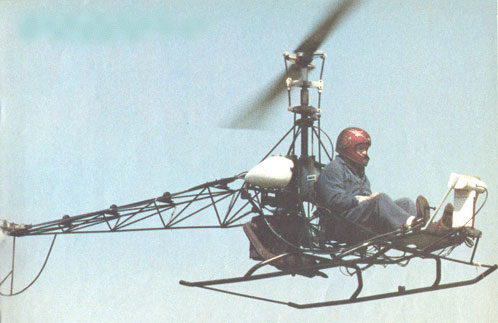
MUSTANG 532 single seat helicopter kit
All gearboxes on the Cobra kit helicopters are made of a special aluminium alloy. This is a very strong, light and reliable alloy. These gearboxes are cast and heat treated, then machined by a highly qualified machinist to top quality tolerances. The gears are made for us by a gear manufacturer and are stressed at well over requirements. At our factory, we assemble the gearboxes complete with gears, input – output shafts, bearings, and seals. They are then sent to our customers as completed, ready – to – install units.
Gary Helton, realises that not everyone wants or needs a beautifully streamlined, Lycoming – powered helicopter. Many homebuilders would be very satisfied with an ultralight – style true helicopter, so he utilised the components from the Commuter II , removed all unnecessary weight, and after substituting the reliable Rotax 503 or 532 engine, called his new ultralight helicopter, the “Mustang”.
The new single – place helicopter, small and ruggedly constructed, may be stored in an average size garage without folding the main rotor blades. It also has an overall height less than most standard garage door heights, thus the owner may store the helicopter in his or her garage, thus saving thousands of dollars a year, which might have been spent for commercial hanger rents.
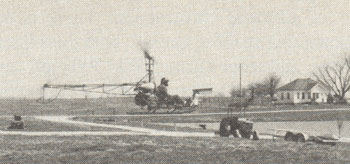
Cobra Helicopter – MUSTANG 532 single seater hovering
Cobra kit helicopters small and rugged construction of the Mustang also has a number of other benefits, one of which is being able to get in and out of many tight locations unreachable in larger helicopters. This enables the pilot to land in small parking lots, yards, or secluded hunting or fishing sites.
Another is that the Mustang’s rugged construction allows it to land off – airport or non – paved areas to get into these secluded spots. The Mustang’s welded tube construction makes the airframe very strong and lightweight. To this airframe are attached two skids which serve as the main landing gear, a type of gear which makes landing in unimproved sites easier and safer, as the skids will span small holes in the ground which a wheel – type landing gear may not. The airframe and landing gear are made of 4130 chromoly steel tubing, the same type used in most small aircraft, helicopters and fixed – wing aircraft, because it’s very strong and able to withstand the flight loads and stresses put on it in this application.
Although, with an empty weight of 366 pounds, the Mustang does not qualify as a true ultralight aircraft in the FAA category or classification, it still weighs less than half of any helicopter available. Considerable engineering and design work was done to reduce the weight to this amount, while still maintaining the requirements of a good rugged and reliable helicopter.
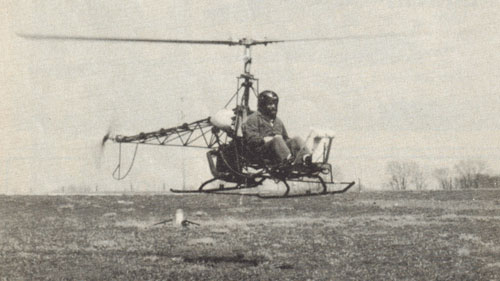
Hovering the MUSTANG 532 single seat personal helicopter
If you have seriously studied the possibility of designing and building your own helicopter, you are aware of the many complex problems to be solved in such an undertaking. Many people have tried this only to find that they have expended many hours of work and several thousand dollars on a machine which might not even get off the ground; or worse yet, may prove to be dangerous to operate.
Designing a helicopter without being aware of the aerodynamics, centrifugal forces and mechanical loads to be encountered can be very costly and very dangerous. Vibrations, gyroscopic forces and unbalanced conditions can destroy a poorly designed helicopter in seconds.
For all these reasons, the Mustang was designed using proven technology in an ultralight airframe with an ultralight engine. The proven technology is the fact that we use the transmission, tail rotor gear box, tail rotor blades and rotor control systems used in the Commuter helicopter. (See full description of Commuter at beginning of this article.)
What makes the Mustang different from the Commuter? The difference lies in using the lighter weight Rotax engine as its power-plant. Although the Rotax was not available when the Commuter was designed, because of the acceleration of ultralight aircraft development during the last several years, the Rotax engine has since proven itself by providing homebuilders with thousands of hours of reliable service. We have coupled the Rotax engine to a new design, a lighter – weight airframe, and the result is the new Mustang.
Before you pilot the Mustang, you’ll need to get instruction from a qualified helicopter instructor. In most moderately large cities, you can find a helicopter operator qualified to give you flight training in his or her machine. If you already have a pilot’s licence, you can step up to a helicopter rating with a small amount of flight instruction, sufficient practise, and a check-ride. Under no circumstances should the builder teach himself to fly his own helicopter without previous training.
NOTE: The Cobra Helicopter Company is no longer in existence and their Cobra, Mustang and Predator helicopters are no longer in production. Article date 1990 courtesy Norm Goyer.
COBRA 2-PLACE GAS TURBINE HELICOPTER

Now you can own the ultimate status symbol at an unbelievable low price. The gas turbine-powered helicopter has always been the ultimate status symbol for executives, presidents, CEOs and the very rich. But you don’t have to be rich to own and operate one of Cobra’s gas turbine-powered helicopters.
Cobra Helicopters, Inc. has taken a unique approach in the affordable gas turbine-powered helicopter by utilizing quick-build kits with pre-molded state-of-the-art carbon fiber composite fuselage, coupled to the best commercial gas turbine engine, the Allison Model 150. They purchase these engines used, and supply them with the helicopter kit, thus giving the kit purchaser a unique product at a very affordable price.
Features of the Cobra two-place gas turbine model include:
-
Quick-build kits with state-of-the-art pre-molded carbon fiber composite fuselage. All machining and welding done.
-
Geared main transmission, geared tail rotor drive, stainless steel tail rotor blades, bonded and riveted main rotor blades.
-
Standard dual controls, with conventional swash plate and stabilizer bar.
-
Choice of engines, Allison gas turbine derated to 205 hp, Lycoming 150-hp aircraft engine, or Subaru 160 hp auto engine.
-
World’s most inexpensive two-place kit helicopters, complete kit with used Allison 250 gas turbine engine less than $50,000 — reciprocating engine models even less.


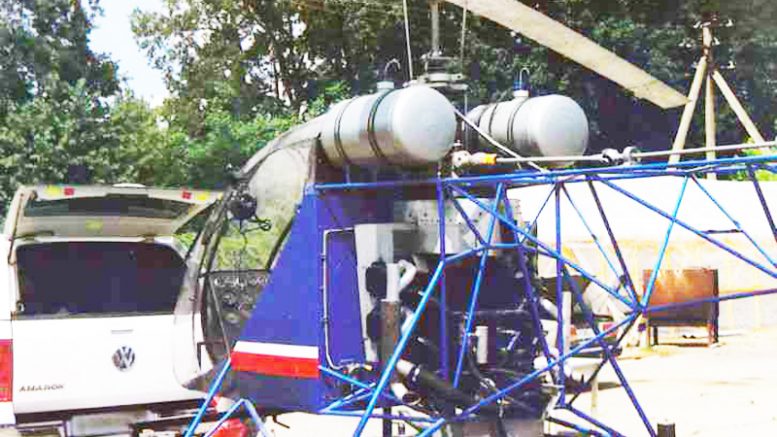
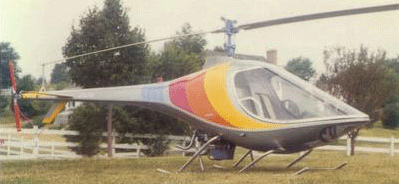
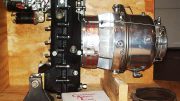
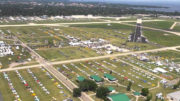
Hello Team,
I am Prithvi Raj from India. I would like to know that can I use a car’s Diesel engine for building a helicopter?. If yes then what should be the HP of the engine?.
A very basic formula to start with is 12 pounds per horsepower. Diesel engines are fine, but can be very heavy.